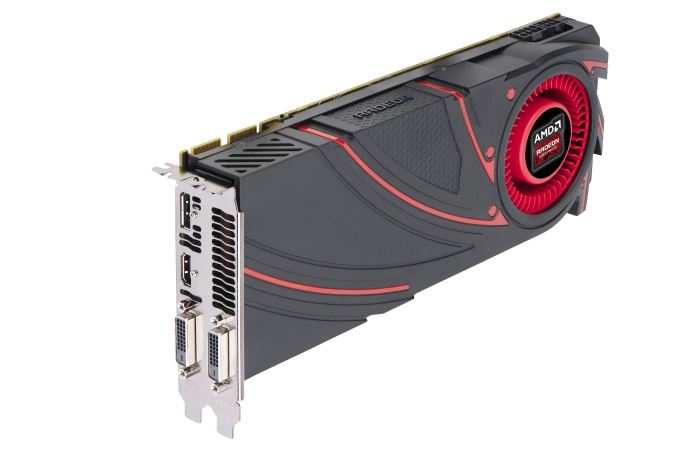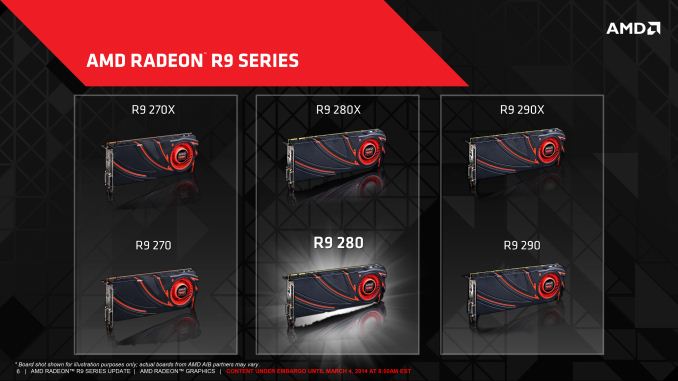AMD Announces Radeon R9 280: Radeon HD 7950 w/Boost Returns
by Ryan Smith on March 4, 2014 8:00 AM EST- Posted in
- GPUs
- AMD
- Radeon
- Radeon 200

With the launch of the Radeon R9 series back in October of 2013, AMD began the process of releasing a number of their existing GCN 1.0 7000 cards as faster 200 series variants. Among the first were the 7970 and 7790, which became the R9 280X and R7 260X respectively; and since then we’ve seen the 7800 series released as the 270 series and 265, and the 7770 as the 250X. At this point AMD has released a 200 series variant of every major 7000 series card except one, the 7950, which was AMD’s lower end Tahiti card.
With that in mind, word comes from today that this is finally changing. As a lot of our regular readers have been expecting, AMD will be releasing a 7950 variant in the form of the R9 280, which is being announced today. The R9 280 will be filling in the same roll that its predecessor filled, which is offering a product between a full Tahiti (280X/7970) and a full Pitcairn (270X/7870) with pricing to match, while also serving as the standard lower tier bin for salvaged Tahiti GPUs. This marks the 3rd such release for the 7950, first being released in its vanilla 7950 form, then in its 7950 with Boost form, and finally now as the R9 280.
| AMD GPU Specification Comparison | ||||||
| AMD Radeon R9 280X | AMD Radeon HD 7970 GHz Edition | AMD Radeon R9 280 | AMD Radeon HD 7950 w/Boost | |||
| Stream Processors | 2048 | 2048 | 1792 | 1792 | ||
| Texture Units | 128 | 128 | 112 | 112 | ||
| ROPs | 32 | 32 | 32 | 32 | ||
| Core Clock | 850MHz | 1000MHz | ? | 850MHz | ||
| Boost Clock | 1000MHz | 1050MHz | 933MHz | 925MHz | ||
| Memory Clock | 6GHz GDDR5 | 6GHz GDDR5 | 5GHz GDDR5 | 5GHz GDDR5 | ||
| Memory Bus Width | 384-bit | 384-bit | 384-bit | 384-bit | ||
| VRAM | 3GB | 3GB | 3GB | 3GB | ||
| FP64 | 1/4 | 1/4 | 1/4 | 1/4 | ||
| TrueAudio | N | N | N | N | ||
| Typical Board Power | 250W | 250W | 250W | 225W | ||
| Manufacturing Process | TSMC 28nm | TSMC 28nm | TSMC 28nm | TSMC 28nm | ||
| Architecture | GCN 1.0 | GCN 1.0 | GCN 1.0 | GCN 1.0 | ||
| GPU | Tahiti | Tahiti | Tahiti | Tahiti | ||
| Launch Date | 10/11/13 | 06/22/12 | 03/04/14 | 08/14/12 | ||
| Launch Price | $299 | $499 | $279 | $329 | ||
The R9 280 isn’t quite a rebadge of the 7950B, but it’s going to be very, very close. The specs provided by AMD put the boost clock at just 8MHz higher than the 7950B, with an unknown base clock (AMD still doesn’t publish that information), and every other aspect remaining unchanged. This means we’re looking at a Tahiti GPU with 28 CUs and all 32 ROPs active. The memory specifications remain similarly unaltered, with AMD outfitting the card with 3GB of 5GHz GDDR5 on a 384-bit bus.
There will be one wildcard however, and that is Typical Board Power. The 7950B was rated for 225W while 280 is rated for 250W. Until we have a card in hand we’re not in a position to tell whether AMD has made any meaningful change here to power limits or chip binning, or if this they’re just assigning the card the 280X’s TBP for consistency’s sake. But of all of the AMD GCN 1.0 cards with PowerTune Boost, this would be the SKU where any power limit increase would be the most meaningful. 7950B required a very big step up in voltage to hit its boost state, causing it to consistently fall back to its base state and putting the card’s average clockspeed well below its top clockspeed.
Assuming for the moment that AMD hasn’t made any power limit changes, then all signs point to 280 performing virtually identical to 7950B given their similar specifications. We’ll see what the final cards are like soon enough, but unless the 280 operates closer to its top clockspeed than 7950B then it shouldn’t be meaningfully different. In which case we’d be looking at roughly 85% of the performance of the 280X.
This is going to be a pure virtual launch for AMD’s partners – AMD hasn’t sampled the press at all – so we haven’t seen any pictures or specifications for the specific SKUs partners will be offering. But at this point it’s safe to assume we’ll see the same designs that were common for the 7950B and 280X, with some overclocked SKUs thrown in for good measure.
Meanwhile for the launch of the 280 AMD has set the MSRP at $279. However retail prices will be highly questionable, as market prices are still supporting $400+ for the 280X. AMD did specifically address pricing in their announcement, stating that they expect the 280 to ease some of these Tahiti supply problems, but all we can do is wait and see.
Following the exceptional demand for the entire R9 Series, we believe the introduction of the R9 280 will help ensure that every gamer who plans to purchase an R9 Series graphics card has an opportunity to do so.
As for availability, that matter is going to be even trickier. This is another soft launch for AMD, with AMD telling us that 280 cards should be available this week with wider availability next week. But after the launches of the 250X and 265 earlier this year, AMD doesn’t have much credibility on soft launches. 250X ended up being a week and a half late, and we’re still waiting on 265 despite AMD’s target of February. So at this point we’re taking AMD’s 280 availability estimates with a grain of salt, as availability this week seems unlikely.
Finally, sizing up the competition the 280 will fall between NVIDIA’s GTX 760 and GTX 770. Where exactly it falls will depend on where street prices are once the 280 launches. At $279 it primarily goes up against the $249 GTX 760, while at street prices over $300 it would be up against the faster $329 GTX 770.
We’re going to have to wait and see what the retail cards perform like and what street prices are, but if performance is similar to the 7950B then AMD will be navigating a very tight spot at $279. In our current benchmark suite the 7950B is roughly 5% faster than the GTX 760, so AMD would have a slight performance advantage but would be at a larger price disadvantage (12%). In which case AMD will also be relying on their value added features such as Mantle and their larger 3GB of VRAM to help carry the difference.
Wrapping things up, we expect to have a 280 card in our hands a bit later this month and we should have hard performance numbers soon. So stay tuned.
| Spring 2014 GPU Pricing Comparison | |||||
| AMD | Price | NVIDIA | |||
| Radeon R9 290 | $500 | GeForce GTX 780 | |||
| Radeon R9 280X | $400 | ||||
| $330 | GeForce GTX 770 | ||||
| Radeon R9 280 (MSRP) | $280 | ||||
| Radeon R9 270X | $270 | ||||
| Radeon R9 270 | $250 | GeForce GTX 760 | |||
| $190 | GeForce GTX 660 | ||||












43 Comments
View All Comments
looncraz - Tuesday, March 4, 2014 - link
Yeah, I really hated that they did that. I have a Phenom II X4 955 in a machine next to me... running at 3.2GHz and 1.2V. It pulls about 75W more at full CPU load than at idle, so the CPU should be drawing a total of only about 90W... I think if I put it on "auto" voltage it runs about 1.38~1.4V and pulls 105~110W.My video card is the same way (7870XT), but as it is a binned chip, that isn't surprising. Still shaved off some significant power draw (it clocks to 1.175GHz without a voltage bump...).
garadante - Tuesday, March 4, 2014 - link
I know Crossfire is a lot more flexible with what cards you can pair together for multi GPu setups than SLI, but I'm not quite certain of just how flexible. Will a 280 be able to Crossfire with a 7950 no problem? Will I need to flash the BIOS on one of them if I wanted to Crossfire them? Thanks for any help!I just wish I had snagged another 7950 when I saw one for $150 on Black Friday. Either for future proofing with Crossfire and the improvements to Crossfire over the last year or so, or to sell both for $300 and snag a 290 or two when AMD prices stabilize.
looncraz - Tuesday, March 4, 2014 - link
280 and a 7950 are practically identical.I think you can XFire: 7870XT + 7950 + 7970 + 280 + 280x without issues.
tuxfool - Tuesday, March 4, 2014 - link
only cards with the same gpu can be crossfired. Therefore only Tahiti can be Xfired with Tahiti. However the faster cards will reduce their performance to match the weaker cards.Gigaplex - Wednesday, March 5, 2014 - link
Are you sure that still applies? They've got Crossfire working with APU + Discrete on completely different architectures (VLIW + GCN).StevoLincolnite - Sunday, March 9, 2014 - link
That's Hybrid Crossfire and comes with some extra caveats. (I.E. Doesn't work in Direct X 9 titles.)juhatus - Tuesday, March 4, 2014 - link
Thanks for reminding, I flashed my 7970 reference to GHz-version, runs cooler now :)minerboy - Tuesday, March 4, 2014 - link
Anandtech should really have a review section that tests cryptocoin mining. May I suggest Maveric7911 gives you a hand?maveric7911 - Tuesday, March 4, 2014 - link
^^ I can help or write another article again let me know guys!hyperspaced - Wednesday, March 5, 2014 - link
I have a 3570K APU with the integrated Intel HD4000 GPU and I add the discrete R9 280 on my system.Assuming a usage scenario of 95% work (no 3D required) and 5% gaming, will I be able to shut down the R9 280 completely (no fan noise, near-zero consumption) when not gaming?